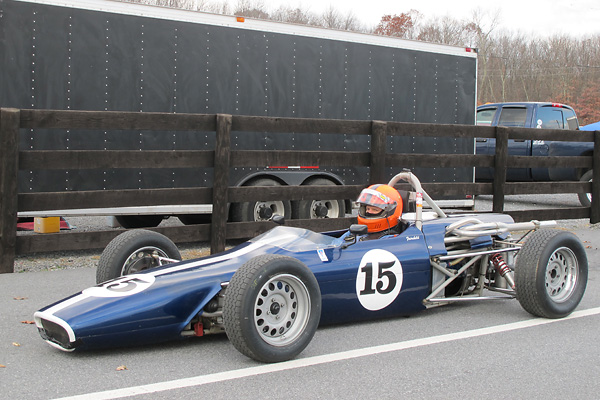
Dave Fairchild's 1969 Merlyn 11A Formula Ford Racecar
Owner: Dave FairchildCity: Richmond Virginia
Model: 1969 Merlyn Eleven-A
Engine: 1.6L Ford four-cylinder
Restored and race prepared by: Dave and his son Scott
Colchester Racing Developments and the Merlyn 11A Model
Merlyn racecars are the most famous products of a family business named Colchester Racing Developments Ltd.
Brother Selwyn Hayward first designed and built a Formula Junior racecar for personal use in 1960. It
must have went well, because he was soon at work developing a Mk2 version. (Four were built.)
Selwyn proved to be a skilled manager and marketeer. His brother Clive joined in the business, and
ultimately proved to be a very gifted designer. Through the sixties and early seventies CRD's principle
business was construction of racecars, stabilized by a successful side business in precision machine work
and fabrication. Having particular skill in "making things" was a competitive advantage because compared
to most other small racecar constructors CRD was able to produce a greater range of parts in house.
The Merlyn Mk10 model was initially developed for Formula Three. When Formula Ford exploded onto
the scene, Merlyn was ready to follow on the heels of Lotus. They simplified and cost-reduced
their existing Formula Three design and fitted a Ford Kent engine to rapidly create a new Formula Ford
model. The Merlyn 11 was available for purchase in 1968, but sales didn't really explode until
1969 when the slightly updated Merlyn 11A was introduced. Orders flooded in from all quarters.
A high percentage of Merlyn's orders came from North America.
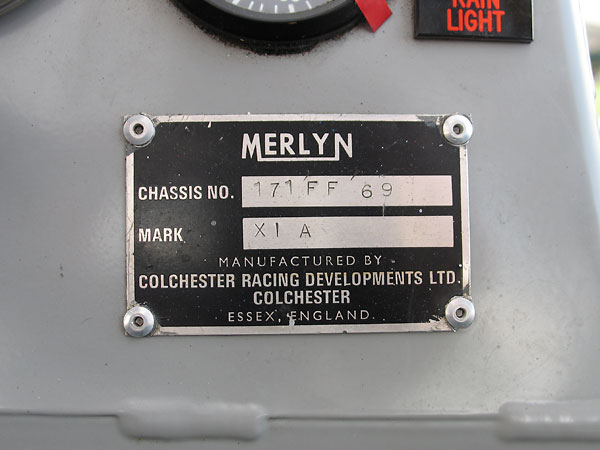
MERLYN
Chassis No.: 171 FF 69 / Mark: XI A
Manufactured by:
Colchester Racing Developments Ltd.
Colchester, Essex, England
The most famous Merlyn 11A became known retrospectively as the "Magic Merlyn". Chassis number 238 was
owned and driven by a young Emerson Fittipaldi in 1969. Fittipaldi drove his 11A for less than a
full season before distinguishing himself and moving on to Formula 3. By the end of 1970 he had won his
first Formula One race. Fittipaldi sold his 11A to Colin Vandervell, son of the famous engine bearing
mogul. Colin Vandervell drove chassis number 238 to many race victories in 1970, and swept the British
Formula Ford championships. Vandervell then sold that very same Merlyn 11A to a youngster named
Jody Scheckter. Scheckter only won one of his eleven races in the Magic Merlyn, but he credits the
car and his time racing it while simultaneously working at the CRD works for teaching him the
subtle art of car set-up and handling. Scheckter followed Fittipaldi to Formula One, where both men
ultimately won world championships.
Through the early seventies Merlyn remained in the top echelon of Formula Ford constructors.
Ultimately however, tool and die work would became a much more lucrative part of the company's
business. In 1979 the Haywards decided to withdraw from racecar production. CRD Tool and Engineering
Limited remains in business to this day and still offers Merlyn spare parts.
Features and Specifications
| Engine: | 1.6L Ford four-cylinder engine, built by Quicksilver RacEngines.
Weber 32/36 DGV carburetor.
Ramair model FF65 air filter.
Bosch distributor.
Pertronix Ignitor breakerless ignition module.
Bosch blue ignition coil.
Taylor Spiro Pro 8mm spark plug wires.
Micro Dynamics "Rev Master" digital rev limiter.
Dry sump lubrication system. |
| Cooling: | custom 22-row crossflow aluminum radiator.
Mocal nine row oil cooler. |
| Exhaust: | four into one header, ceramic coated. |
| Transmission: | Hewland Mk9 (H9-6370) 4-speed.
9.31 crown wheel and pinion (i.e. 3.44:1 final drive ratio.)
Open differential.
Tilton 7.25" clutch. |
| Front Susp.: | unequal length wide-based wishbones.
Triumph (Alford & Alder, forged) uprights.
Koni aluminum bodied double adjustable coilover shock absorbers.
Eibach springs.
Adjustable anti-sway bar. |
| Rear Susp.: | inverted lower wishbones, single top links, and twin adjustable trailing links.
Proprietary Merlyn magnesium uprights.
Koni aluminum bodied double adjustable coilover shock absorbers.
Eibach springs.
Adjustable anti-sway bar. |
| Brakes: | (master) dual Girling master cylinders with Tilton remotely adjustable bias bar, (front) Girling 14LF calipers. Brembo rotors. Hawk "blue" pads, (rear) Girling 12SP calipers. Brembo rotors. Hawk "blue" pads. |
| Wheels/Tires: | steel disc wheels.
Dunlop Racing "Formula Ford" tires (135/545-13 CR82 front, 165/580-13 CR82 rear). |
| Electrical: | DMS/Varley red top battery (mounted under seat).
Tilton Super Starter. |
| Instruments: | (left to right) AutoMeter oil temperature gauge (140-280F),
Jones tachometer (1000-8000rpm),
Racetech dual oil pressure (0-100psi) and coolant temperature (30-110C) gauge.
AutoMeter hour meter (mounted on front bulkhead). |
| Fuel System: | under seat fuel cell. FF1600 fuel pump with push-on fittings. |
| Safety Eqmt: | custom-fitted drivers seat.
Willans six-point cam-lock safety harness.
FireBottle fire suppression system.
Quick release steering wheel hub, on a RaceTech suede covered steering wheel. |
| Weight: | ~925 pounds. |
| Racing Class: | Formula Ford |
Engine Installation
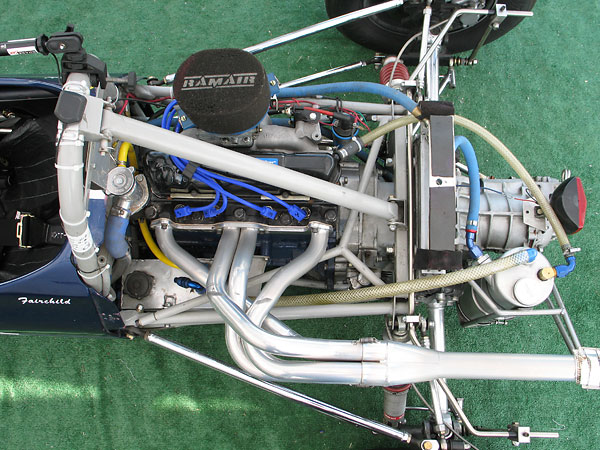
1.6L Ford four-cylinder engine, built by Quicksilver RacEngines.
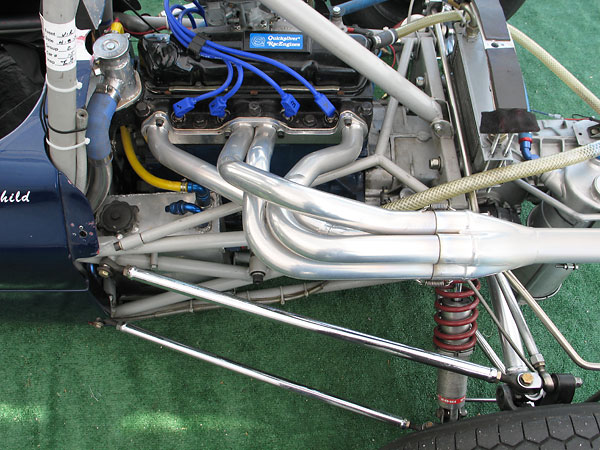
Four into one header, ceramic coated.
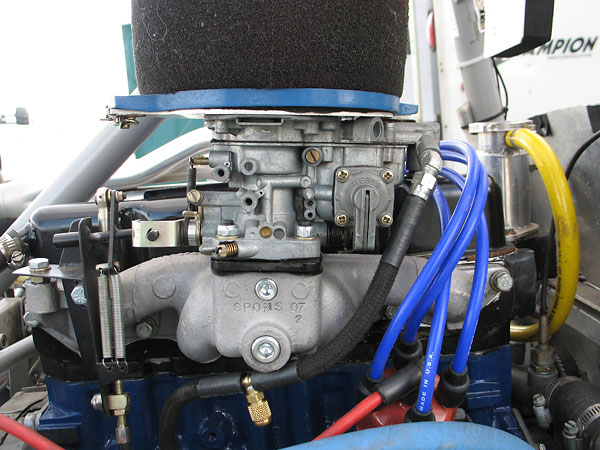
Weber 32/36 DGV carburetor. Ramair model FF65 air filter.
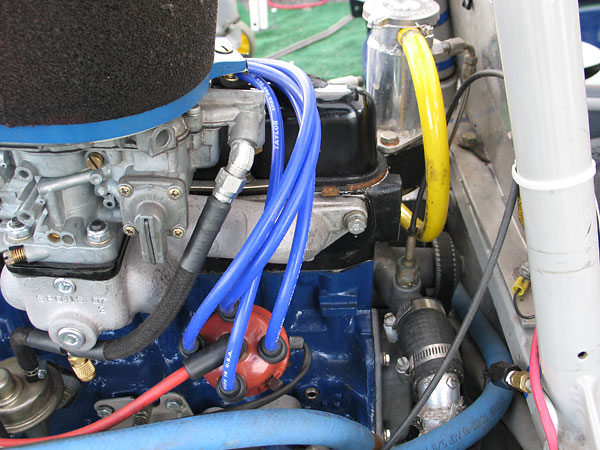
Bosch distributor with Pertronix Ignitor breakerless ignition module inside.
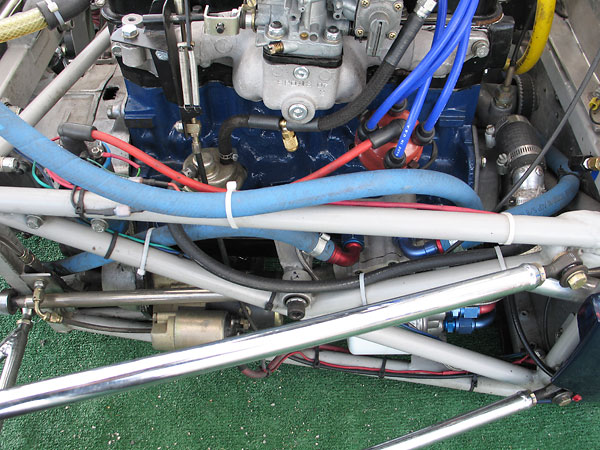
Bosch "blue" ignition coil and Taylor Spiro Pro 8mm spark plug wires.
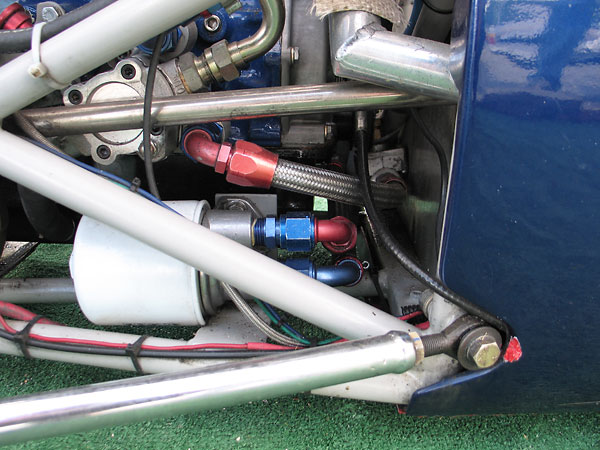
BAT oil pump cover.
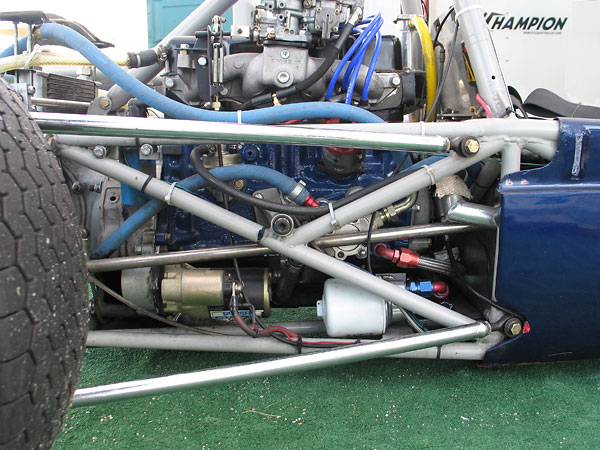
Tilton Super Starter.
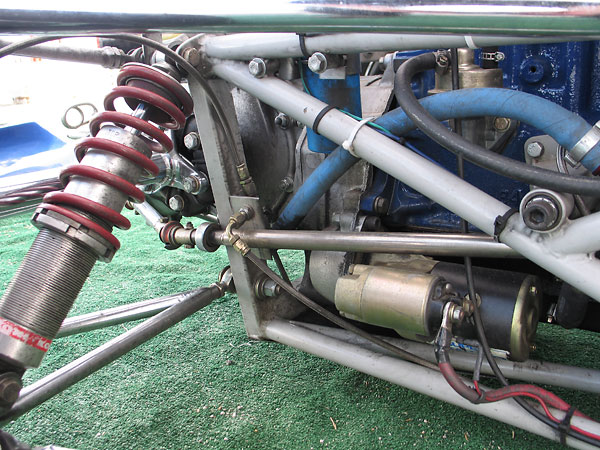
FF1600 fuel pump with push-on fittings.
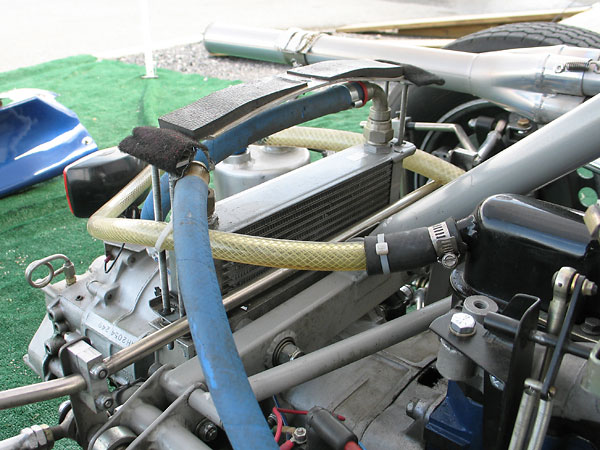
Mocal nine row oil cooler.
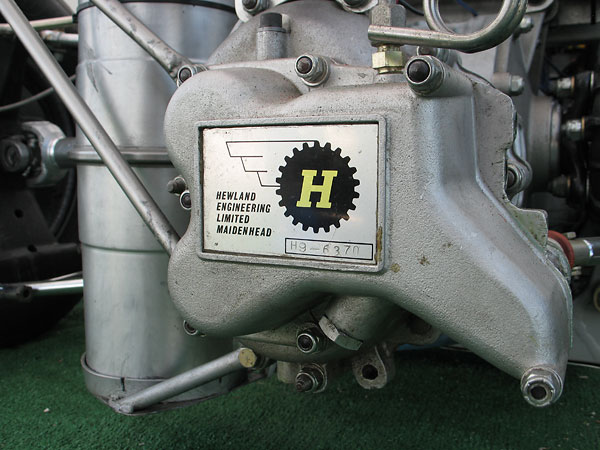
Hewland Mk9 (H9-6370) 4-speed.
Enjoying this article? www.BritishRaceCar.com is partially funded through generous support from readers like you!
To contribute to our operating budget, please click here and follow the instructions.
(Suggested contribution is twenty bucks per year. Feel free to give more!)
Front Suspension
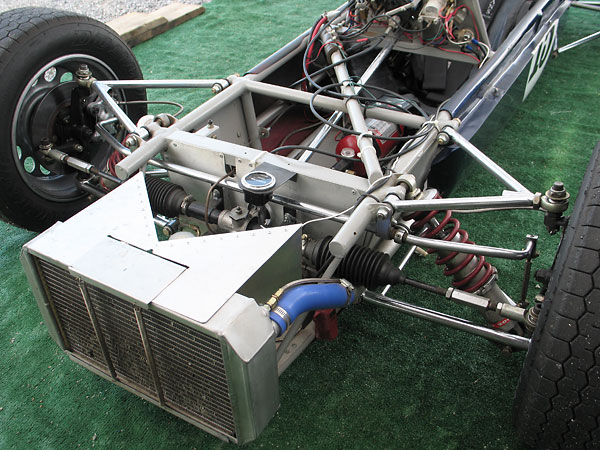
Engine coolant was originally routed through frame tubes, but now the tubes have been capped off.
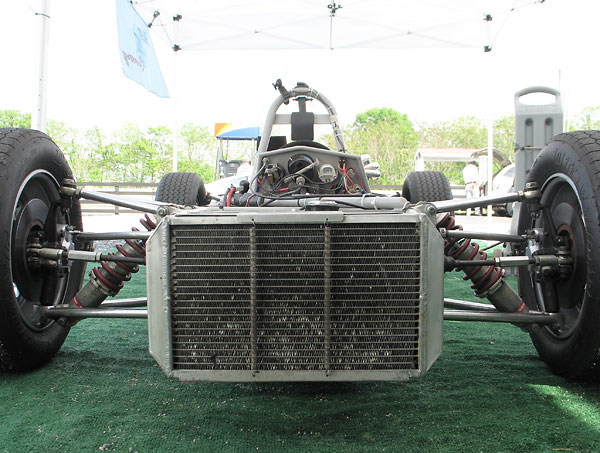
This large, aluminum crossflow radiator is a modern upgrade.
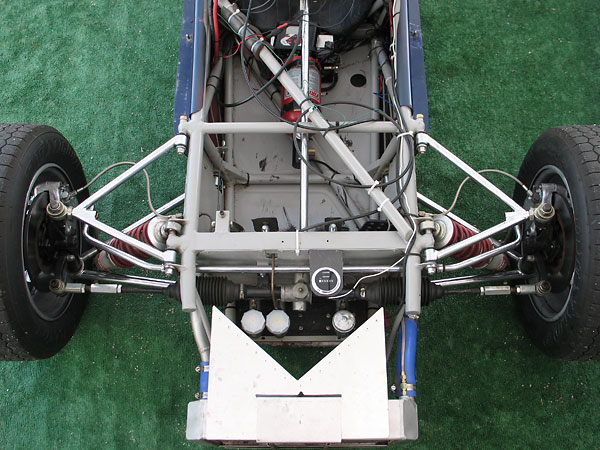
Airflow from the radiator core is diverted off to either side, and exits at suspension openings.
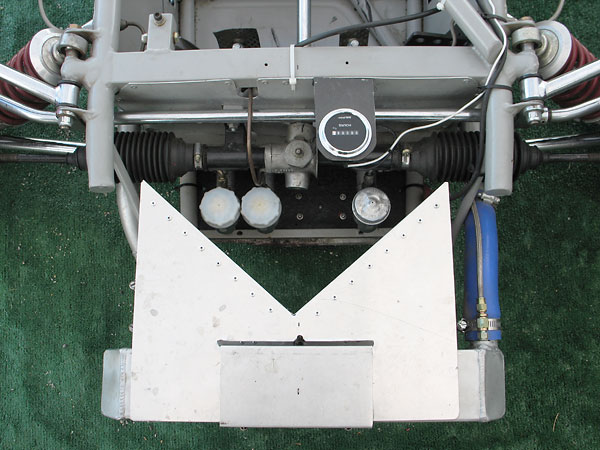
Dual Girling master cylinders with bias bar.
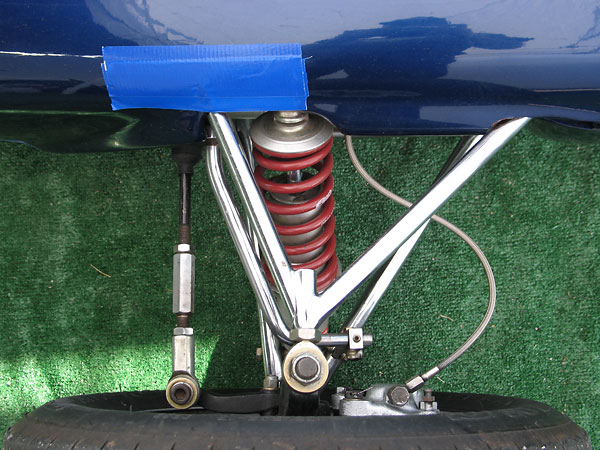
Only very minimal tuning of front suspension geometry is feasible because the control arms have
fixed-length ends instead of threaded Heim joints in ten of twelve possible positions.
This particular Heim joint appears to be adjusted to the very limit of its range.
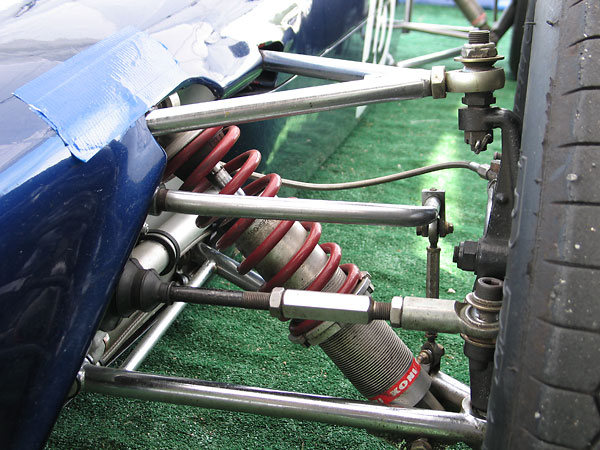
Koni aluminum bodied double adjustable coilover shock absorbers and Eibach springs.
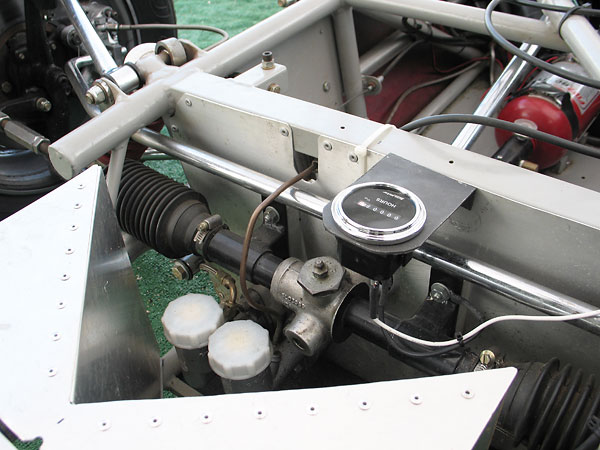
Cut-down steering rack.
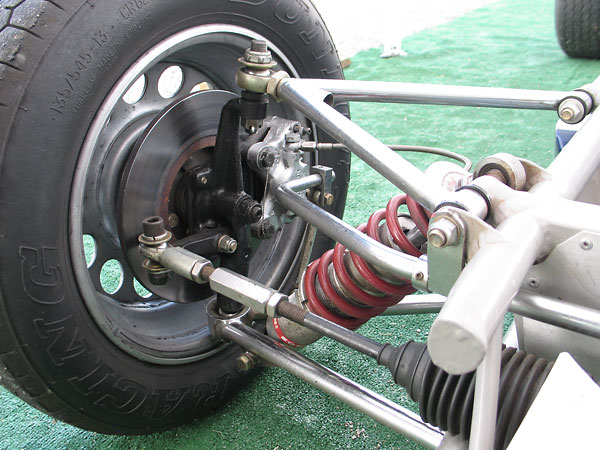
This nifty steering adapter has a left-hand female thread and a right-hand male thread to make
toe adjustments quick and simple. Just rotate the adapter to change its installed length.
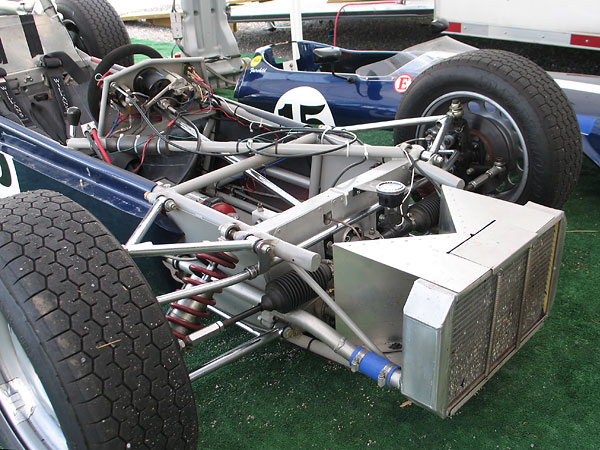
Triangulation, the installation of frame members that span rectangular bays to connect opposite nodes,
provides a great boost to chassis rigidity and strength. Without adequate triangulation, welded joints are
more heavily stressed. A distinctive feature of Merlyn 11/11A frames is a peculiar out-of-plane diagonal
that spans from the top lefthand corner of the front bulkhead to the righthand edge of the dashboard.
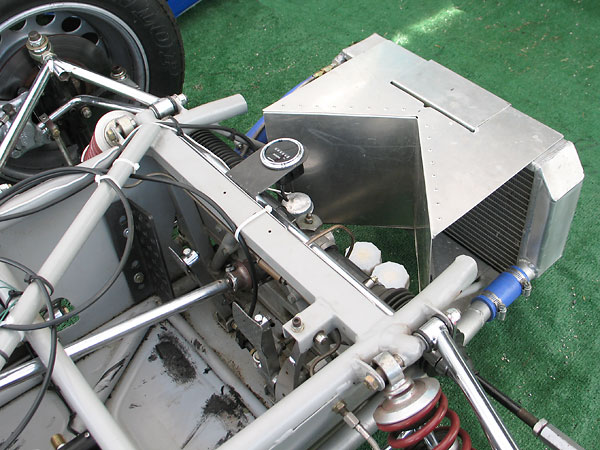
Another way to triangulate a four bar linkage is to install a stressed skin. Here, both sides of the
footbox have steel sheetmetal stitch-welded into place. If these panels had extended rearward down
the length of the driver compartment, they would've been in clear violation of Formula Ford rules.
(Formula Ford rules proscribed 6-inch or greater rivet spacing when side panels were applied.)
Rear Suspension
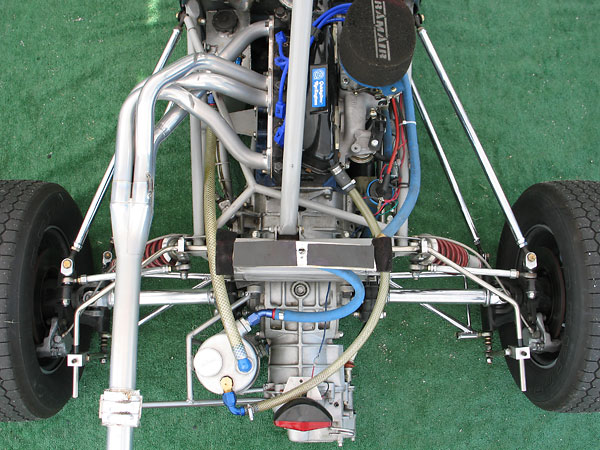
In overview, the Merlyn 11A rear suspension looks similar to nearly every "Formula car" of its era:
inverted lower wishbones, single top links, and twin adjustable trailing links.
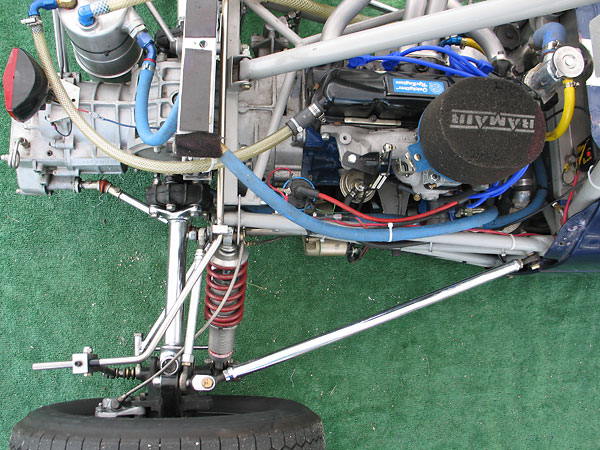
All eight rear suspension pick-up points on the Merlyn 11A frame are in single shear.
Contrast this, for example, with son
Scott's Royale RP3¹
where all eight Heim joints are
supported by double shear connections. It's a tiny design detail, but an important one.
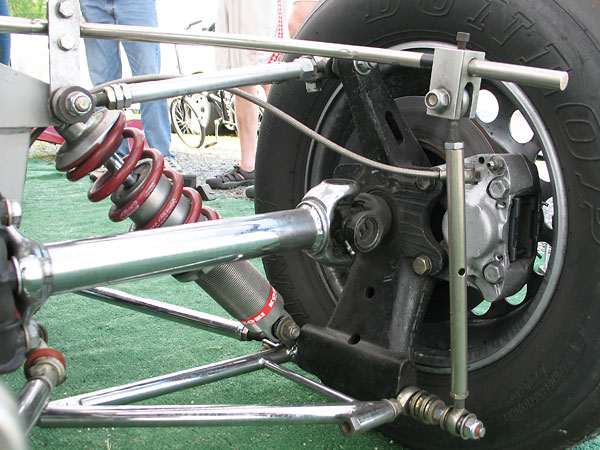
Koni aluminum bodied double adjustable coilover shock absorbers and Eibach springs.
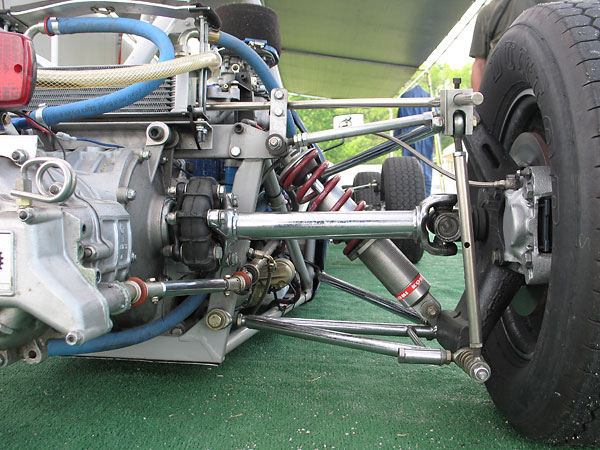
Rubber drive donuts were exclusively specified by Formula Ford class rules. In today's world, CV joints
would seem an appealing option because they're maintenance free and they should last much longer.
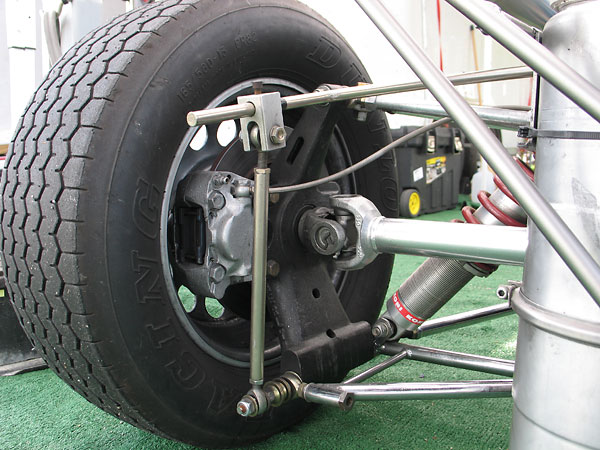
Merlyn's proprietary cast magnesium rear uprights, and an adjustable anti-roll bar.
Interior
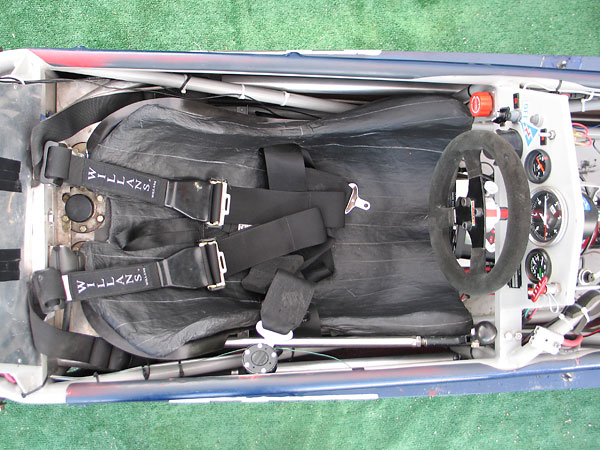
Custom-fitted drivers seat.
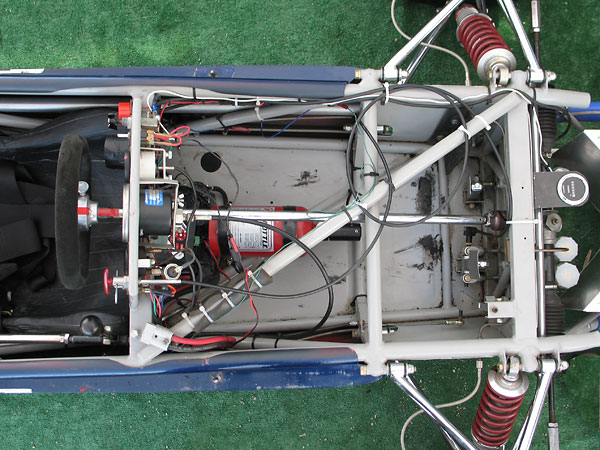
FireBottle fire suppression system.
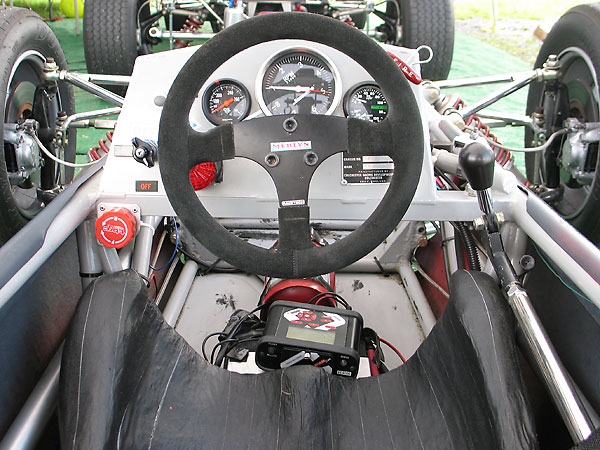
RaceTech suede covered steering wheel.
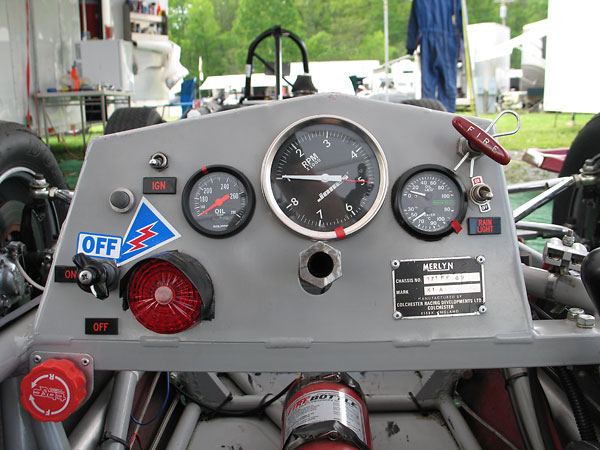
AutoMeter oil temperature gauge (140-280F), Jones tachometer (1000-8000rpm), and
Racetech dual oil pressure (0-100psi) and coolant temperature (30-110C) gauge.
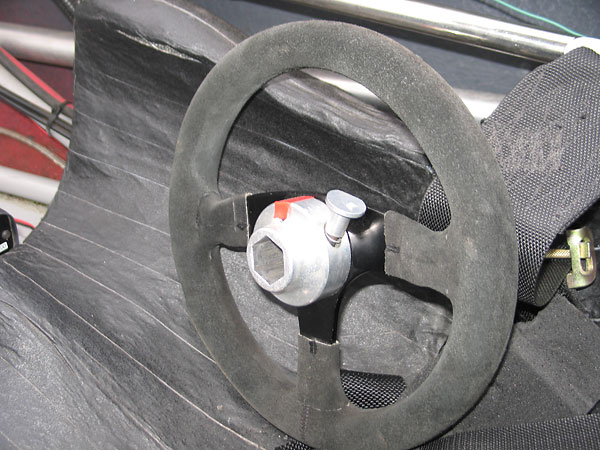
Quick release steering wheel hub.
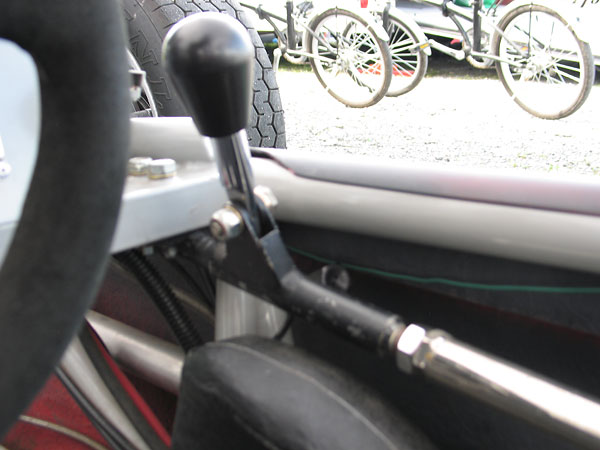
Merlyn 11A gear selector lever.
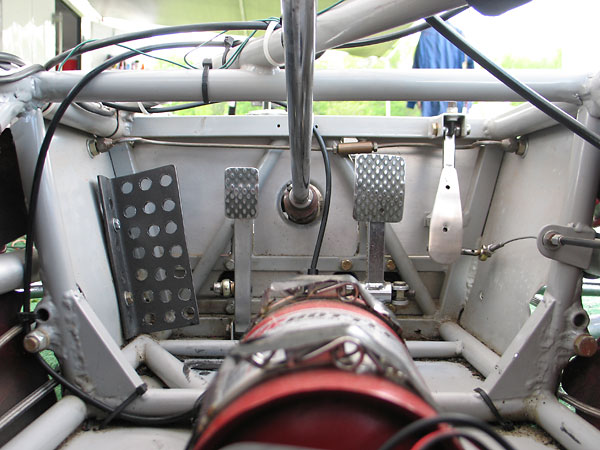
Merlyn 11A footbox.
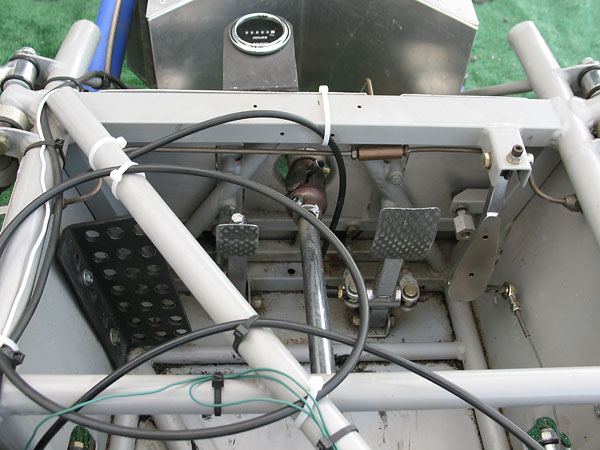
AutoMeter hour meter (mounted on front bulkhead), showing 8.7 hours elapsed.
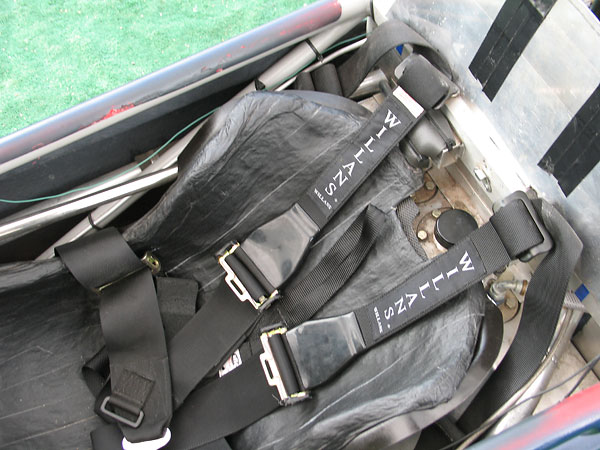
Willans six-point cam-lock safety harness.
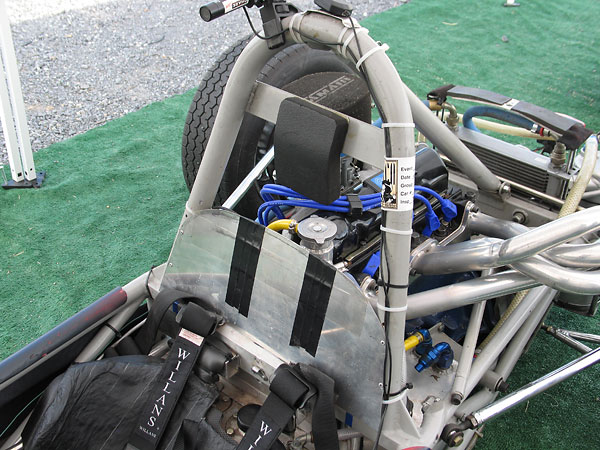
Padded head rest, and raised roll hoop.
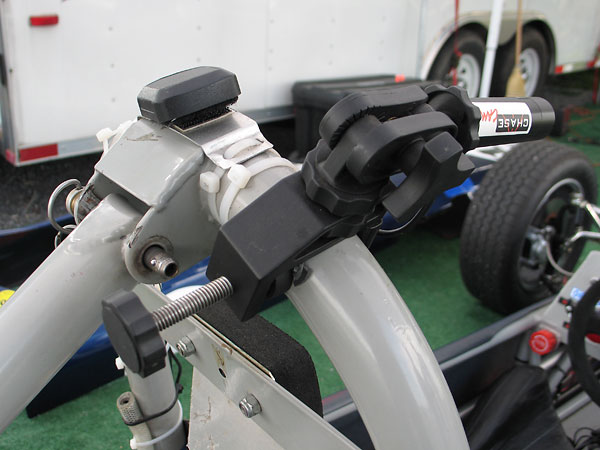
Chase Cam camera bracket.
Exterior
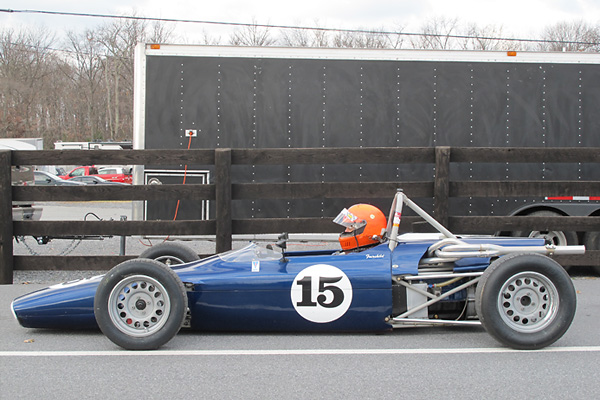
Merlyn produced especially attractively styled Formula Fords.
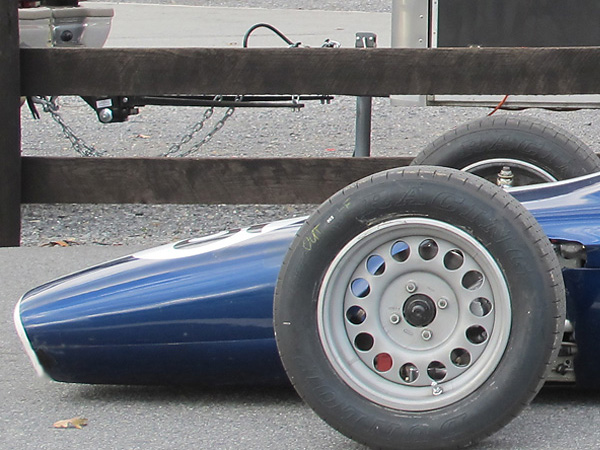
Steel disc wheels, as traditionally required by Formula Ford class rules.
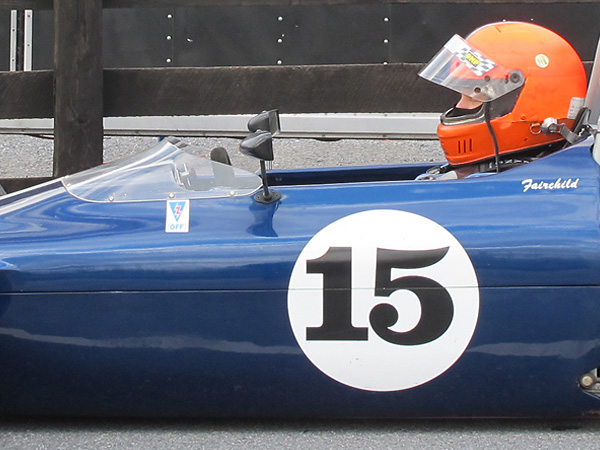
Most days he's a banker... in daydreams he might be the next Emerson Fittipaldi or Jody Scheckter.
Even in "vintage" events, Formula Ford remains a particularly competitive racing class; one that
especially rewards skill, athleticism, courage, and concentration.
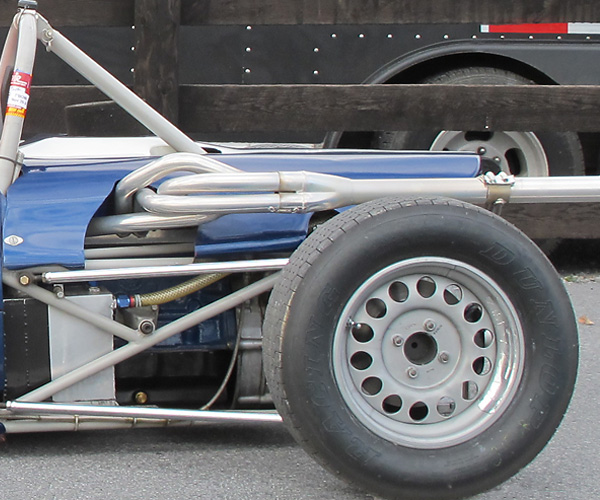
Dunlop Racing "Formula Ford" tires (135/545-13 CR82 front, 165/580-13 CR82 rear).
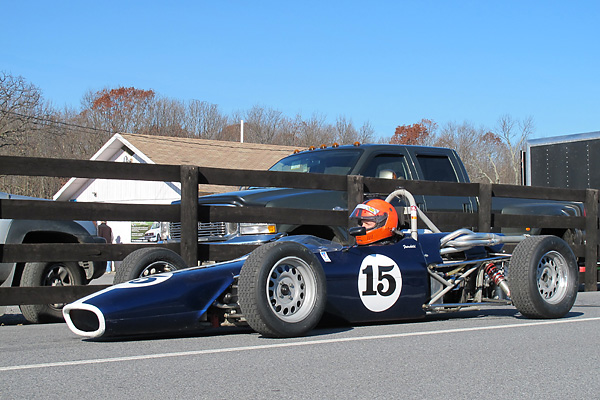
Class of 1969: Merlyn's 11A model Formula Ford racecar.
| Notes: | |||||||
| (1) |
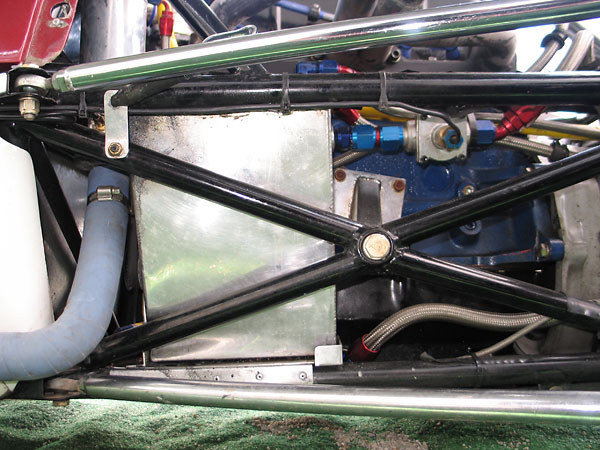 Fasteners are said to be utilized in "single shear" as opposed to "double shear" when strain on the fastener in question is applied to just one shear plane as opposed to two shear planes respectively. In the latter case - illustrated here with trailing link brackets on a Royale RP3-A Formula Ford - the cross-sectional area of strain is literally twice as large and therefore twice as strong. In practice, double shear connections are usually even more than twice as robust. In the case of bolted joints, double shear connection makes it easier for the designer to ensure thread roots won't be aligned with a shear plane. | ||||||
All photos shown here are from April 2010 when we viewed the car at VRG's Jefferson 500
at Summit Point Motorsports Park, West Virginia. Photos by Curtis Jacobson for BritishRaceCar.com,
copyright 2010. All rights reserved.
| If you liked this article, you'll probably also enjoy these: | |||||
 |
Dick Leehr 1968 Lotus 51c |
 |
Jeff Snook 1968 Alexis Mk14 |
 |
Scott Fairchild 1972 Royale RP3A |
| You're invited to discuss anything you've seen here on The British Racecar Motorsports Forum! | |||||
Notice: all the articles and almost all the photos on BritishRacecar.com are by Curtis Jacobson.
(Photos that aren't by Curtis are explicitly credited.) Reproduction without prior written permission is prohibited.
Contact us to purchase images or reproduction permission. Higher resolution images are optionally available.


